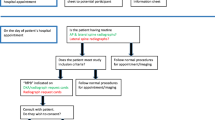Abstract
Summary
Establishing the hospital’s own standard operating procedures (SOPs) and team training including physicians and technologists reduces the error rate of dual-energy X-ray absorptiometry (DXA) measurement. In addition, when monitoring DXA images, it is necessary to check whether region of interest (ROI) and bone mapping are properly set as well as patient positioning.
Introduction
Physicians often experience poor quality DXA images, which affects osteoporosis treatment. The purpose of this study is to analyze the change in the error rate of DXA images after a multidisciplinary team training including physicians and technologists.
Methods
Experienced physicians and DXA technologists formed a training team to establish SOPs for DXA measurement. The training team instructed the other related hospital personnel for a month. We set the criteria of measurement errors (9 items for the lumbar spine image and 8 items for the proximal femur image). With these criteria, a total of 637 images (320 images before training and 317 images after training) were analyzed to check the frequency and distribution of errors before and after training.
Results
The most common error when measuring the lumbar spine image before training was inadequate bone mapping (51.9%), and when measuring the proximal femur image was the incorrect area of the ROI of the femoral neck (37.2%). The most improved error after training was inadequate bone mapping (33.3% improvement) in the lumbar spine image and inadequate internal rotation (13.6% improvement) in the proximal femur image. Errors were significantly reduced by 23.2% in the lumbar spine, 9.0% in the proximal femur, and 9.2% in both the regions.
Conclusions
Establishing SOPs and multidisciplinary team training effectively reduced the error rate of DXA images.




Similar content being viewed by others
References
Kanis JA (2002) Diagnosis of osteoporosis and assessment of fracture risk. Lancet 359(9321):1929–1936. https://doi.org/10.1016/S0140-6736(02)08761-5
WHO (2007) Assessment of osteoporosis at the primary health care level. Report of a WHO Scientific Group. http://www.who.int/chp/topics/rheumatic/en/index.html. http://www.who.int/chp/topics/rheumatic/en/index.html. Accessed 10 April 2020
Karahan AY, Kaya B, Kuran B, Altindag O, Yildirim P, Dogan SC, Basaran A, Salbas E, Altinbilek T, Guler T, Tolu S, Hasbek Z, Ordahan B, Kaydok E, Yucel U, Yesilyurt S, Polat AD, Cubukcu M, Nas O, Sarp U, Yasar O, Kucuksarac S, Turkoglu G, Karadag A, Bagcaci S, Erol K, Guler E, Tuna S, Yildirim A, Karpuz S (2016) Common mistakes in the dual-energy X-ray absorptiometry (DXA) in Turkey. A retrospective descriptive multicenter study. Acta Med (Hradec Kralove) 59(4):117–123. https://doi.org/10.14712/18059694.2017.38
Watts NB (2004) Fundamentals and pitfalls of bone densitometry using dual-energy X-ray absorptiometry (DXA). Osteoporos Int 15(11):847–854. https://doi.org/10.1007/s00198-004-1681-7
Lewiecki EM, Binkley N, Petak SM (2006) DXA quality matters. J Clin Densitom 9(4):388–392. https://doi.org/10.1016/j.jocd.2006.07.002
Lewiecki EM, Lane NE (2008) Common mistakes in the clinical use of bone mineral density testing. Nat Clin Pract Rheumatol 4(12):667–674. https://doi.org/10.1038/ncprheum0928
Messina C, Bandirali M, Sconfienza LM, D'Alonzo NK, Di Leo G, Papini GD, Ulivieri FM, Sardanelli F (2015) Prevalence and type of errors in dual-energy x-ray absorptiometry. Eur Radiol 25(5):1504–1511. https://doi.org/10.1007/s00330-014-3509-y
Lewiecki EM, Binkley N, Morgan SL, Shuhart CR, Camargos BM, Carey JJ, Gordon CM, Jankowski LG, Lee JK, Leslie WD, International Society for Clinical D (2016) Best practices for dual-energy X-ray absorptiometry measurement and reporting: International Society for Clinical Densitometry Guidance. J Clin Densitom 19(2):127–140. https://doi.org/10.1016/j.jocd.2016.03.003
Krueger D, Binkley N, Morgan S (2018) Dual-energy X-ray absorptiometry quality matters. J Clin Densitom 21(2):155–156. https://doi.org/10.1016/j.jocd.2017.10.002
Kim H, Kim HS, Moon ES, Yoon CS, Chung TS, Song HT, Suh JS, Lee YH, Kim S (2010) Scoliosis imaging: what radiologists should know. Radiographics 30(7):1823–1842. https://doi.org/10.1148/rg.307105061
Promma S, Sritara C, Wipuchwongsakorn S, Chuamsaamarkkee K, Utamakul C, Chamroonrat W, Kositwattanarerk A, Anongpornjossakul Y, Thamnirat K, Ongphiphadhanakul B (2018) Errors in patient positioning for bone mineral density assessment by dual X-ray absorptiometry: effect of technologist retraining. J Clin Densitom 21(2):252–259. https://doi.org/10.1016/j.jocd.2017.07.004
Kim JM, Lee BS, Bin SI (2018) Editorial commentary: meniscal allograft transplantation: still effective with poor cartilage, but much better with good cartilage-better done earlier. Arthroscopy 34(6):1877–1878. https://doi.org/10.1016/j.arthro.2018.02.016
Cetin A, Ozguclu E, Ozcakar L, Akinci A (2008) Evaluation of the patient positioning during DXA measurements in daily clinical practice. Clin Rheumatol 27(6):713–715. https://doi.org/10.1007/s10067-007-0773-0
Maldonado G, Intriago M, Larroude M, Aguilar G, Moreno M, Gonzalez J, Vargas S, Vera C, Rios K, Rios C (2020) Common errors in dual-energy X-ray absorptiometry scans in imaging centers in Ecuador. Arch Osteoporos 15(1):6. https://doi.org/10.1007/s11657-019-0673-3
Morgan SL, Prater GL (2017) Quality in dual-energy X-ray absorptiometry scans. Bone 104:13–28. https://doi.org/10.1016/j.bone.2017.01.033
Peel NF, Johnson A, Barrington NA, Smith TW, Eastell R (1993) Impact of anomalous vertebral segmentation on measurements of bone mineral density. J Bone Miner Res 8(6):719–723. https://doi.org/10.1002/jbmr.5650080610
Lorente Ramos RM, Azpeitia Arman J, Arevalo Galeano N, Munoz Hernandez A, Garcia Gomez JM, Gredilla Molinero J (2012) Dual energy X-ray absorptimetry: fundamentals, methodology, and clinical applications. Radiologia 54(5):410–423. https://doi.org/10.1016/j.rx.2011.09.023
Garg MK, Kharb S (2013) Dual energy X-ray absorptiometry: pitfalls in measurement and interpretation of bone mineral density. Indian J Endocrinol Metab 17(2):203–210. https://doi.org/10.4103/2230-8210.109659
Leslie WD, Manitoba Bone Density P (2006) The impact of bone area on short-term bone density precision. J Clin Densitom 9(2):150–153. https://doi.org/10.1016/j.jocd.2005.12.001
Kline GA, Hanley DA (2006) Differences of vertebral area in serial bone density measurements: a common source of potential error in interpretation of BMD change. J Clin Densitom 9(4):419–424. https://doi.org/10.1016/j.jocd.2006.08.006
Acknowledgments
We would like to thank Editage (www.editage.co.kr) for English language editing.
Funding
This study was supported by a grant from the Basic Science Research Program through the National Research Foundation (NRF) funded by the Korean Ministry of Education, Science and Technology (KR) [NRF-2019R1C1C1010602] to JWH.
Author information
Authors and Affiliations
Corresponding authors
Ethics declarations
This study was approved by the Institutional Review Board of the Korean National Medical Center (approval no. H-1906-103-00).
Conflicts of interest
None.
Additional information
Publisher’s note
Springer Nature remains neutral with regard to jurisdictional claims in published maps and institutional affiliations.
Rights and permissions
About this article
Cite this article
Jung, E.Y., Park, Sj., Shim, H.E. et al. Multidisciplinary team training reduces the error rate of DXA image. Arch Osteoporos 15, 115 (2020). https://doi.org/10.1007/s11657-020-00791-8
Received:
Accepted:
Published:
DOI: https://doi.org/10.1007/s11657-020-00791-8




